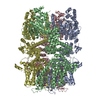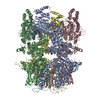[English] 日本語
 Yorodumi
Yorodumi- PDB-6bqv: Human TRPM4 ion channel in lipid nanodiscs in a calcium-bound state -
+ Open data
Open data
- Basic information
Basic information
| Entry | Database: PDB / ID: 6bqv | ||||||||||||||||||
|---|---|---|---|---|---|---|---|---|---|---|---|---|---|---|---|---|---|---|---|
| Title | Human TRPM4 ion channel in lipid nanodiscs in a calcium-bound state | ||||||||||||||||||
 Components Components | Transient receptor potential cation channel subfamily M member 4 | ||||||||||||||||||
 Keywords Keywords | MEMBRANE PROTEIN / TRPM4 / TRPM channel / TRP channel | ||||||||||||||||||
| Function / homology |  Function and homology information Function and homology informationpositive regulation of atrial cardiac muscle cell action potential / positive regulation of regulation of vascular associated smooth muscle cell membrane depolarization / sodium channel complex / regulation of T cell cytokine production / membrane depolarization during AV node cell action potential / membrane depolarization during bundle of His cell action potential / membrane depolarization during Purkinje myocyte cell action potential / negative regulation of bone mineralization / ligand-gated calcium channel activity / sodium ion import across plasma membrane ...positive regulation of atrial cardiac muscle cell action potential / positive regulation of regulation of vascular associated smooth muscle cell membrane depolarization / sodium channel complex / regulation of T cell cytokine production / membrane depolarization during AV node cell action potential / membrane depolarization during bundle of His cell action potential / membrane depolarization during Purkinje myocyte cell action potential / negative regulation of bone mineralization / ligand-gated calcium channel activity / sodium ion import across plasma membrane / regulation of ventricular cardiac muscle cell action potential / calcium-activated cation channel activity / inorganic cation transmembrane transport / TRP channels / dendritic cell chemotaxis / sodium channel activity / cellular response to ATP / positive regulation of heart rate / regulation of heart rate by cardiac conduction / positive regulation of insulin secretion involved in cellular response to glucose stimulus / protein sumoylation / positive regulation of fat cell differentiation / negative regulation of osteoblast differentiation / positive regulation of vasoconstriction / positive regulation of adipose tissue development / calcium-mediated signaling / calcium ion transmembrane transport / Sensory perception of sweet, bitter, and umami (glutamate) taste / positive regulation of canonical Wnt signaling pathway / positive regulation of cytosolic calcium ion concentration / protein homotetramerization / adaptive immune response / calmodulin binding / neuronal cell body / positive regulation of cell population proliferation / calcium ion binding / Golgi apparatus / endoplasmic reticulum / nucleoplasm / ATP binding / identical protein binding / membrane / plasma membrane / cytosol Similarity search - Function | ||||||||||||||||||
| Biological species |  Homo sapiens (human) Homo sapiens (human) | ||||||||||||||||||
| Method | ELECTRON MICROSCOPY / single particle reconstruction / cryo EM / Resolution: 3.1 Å | ||||||||||||||||||
 Authors Authors | Autzen, H.E. / Myasnikov, A.G. / Campbell, M.G. / Asarnow, D. / Julius, D. / Cheng, Y. | ||||||||||||||||||
| Funding support |  United States, United States,  Denmark, 5items Denmark, 5items
| ||||||||||||||||||
 Citation Citation |  Journal: Science / Year: 2018 Journal: Science / Year: 2018Title: Structure of the human TRPM4 ion channel in a lipid nanodisc. Authors: Henriette E Autzen / Alexander G Myasnikov / Melody G Campbell / Daniel Asarnow / David Julius / Yifan Cheng /   Abstract: Transient receptor potential (TRP) melastatin 4 (TRPM4) is a widely expressed cation channel associated with a variety of cardiovascular disorders. TRPM4 is activated by increased intracellular ...Transient receptor potential (TRP) melastatin 4 (TRPM4) is a widely expressed cation channel associated with a variety of cardiovascular disorders. TRPM4 is activated by increased intracellular calcium in a voltage-dependent manner but, unlike many other TRP channels, is permeable to monovalent cations only. Here we present two structures of full-length human TRPM4 embedded in lipid nanodiscs at ~3-angstrom resolution, as determined by single-particle cryo-electron microscopy. These structures, with and without calcium bound, reveal a general architecture for this major subfamily of TRP channels and a well-defined calcium-binding site within the intracellular side of the S1-S4 domain. The structures correspond to two distinct closed states. Calcium binding induces conformational changes that likely prime the channel for voltage-dependent opening. | ||||||||||||||||||
| History |
|
- Structure visualization
Structure visualization
| Movie |
 Movie viewer Movie viewer |
|---|---|
| Structure viewer | Molecule:  Molmil Molmil Jmol/JSmol Jmol/JSmol |
- Downloads & links
Downloads & links
- Download
Download
| PDBx/mmCIF format |  6bqv.cif.gz 6bqv.cif.gz | 671.4 KB | Display |  PDBx/mmCIF format PDBx/mmCIF format |
|---|---|---|---|---|
| PDB format |  pdb6bqv.ent.gz pdb6bqv.ent.gz | 536.7 KB | Display |  PDB format PDB format |
| PDBx/mmJSON format |  6bqv.json.gz 6bqv.json.gz | Tree view |  PDBx/mmJSON format PDBx/mmJSON format | |
| Others |  Other downloads Other downloads |
-Validation report
| Arichive directory |  https://data.pdbj.org/pub/pdb/validation_reports/bq/6bqv https://data.pdbj.org/pub/pdb/validation_reports/bq/6bqv ftp://data.pdbj.org/pub/pdb/validation_reports/bq/6bqv ftp://data.pdbj.org/pub/pdb/validation_reports/bq/6bqv | HTTPS FTP |
|---|
-Related structure data
| Related structure data |  7133MC  7132C  6bqrC M: map data used to model this data C: citing same article ( |
|---|---|
| Similar structure data | |
| EM raw data |  EMPIAR-10127 (Title: Human TRPM4 ion channel in a lipid nanodisc in a calcium-bound state EMPIAR-10127 (Title: Human TRPM4 ion channel in a lipid nanodisc in a calcium-bound stateData size: 84.4 Data #1: particle stacks of TRPM4 particles post 2D clean-up [picked particles - multiframe - processed]) |
| Experimental dataset #1 | Data reference:  10.6019/EMPIAR-10127 / Data set type: EMPIAR 10.6019/EMPIAR-10127 / Data set type: EMPIAR |
- Links
Links
- Assembly
Assembly
| Deposited unit | 
|
|---|---|
| 1 |
|
- Components
Components
| #1: Protein | Mass: 134770.734 Da / Num. of mol.: 4 Source method: isolated from a genetically manipulated source Source: (gene. exp.)  Homo sapiens (human) / Gene: TRPM4, LTRPC4 / Production host: Homo sapiens (human) / Gene: TRPM4, LTRPC4 / Production host:  Homo sapiens (human) / References: UniProt: Q8TD43 Homo sapiens (human) / References: UniProt: Q8TD43#2: Chemical | ChemComp-CA / #3: Chemical | ChemComp-Y01 / |
|---|
-Experimental details
-Experiment
| Experiment | Method: ELECTRON MICROSCOPY |
|---|---|
| EM experiment | Aggregation state: PARTICLE / 3D reconstruction method: single particle reconstruction |
- Sample preparation
Sample preparation
| Component | Name: Human TRPM4 ion channel / Type: COMPLEX Details: Human TRPM4 ion channel in lipid nanodiscs in a calcium-bound state Entity ID: #1 / Source: RECOMBINANT | ||||||||||||||||||||
|---|---|---|---|---|---|---|---|---|---|---|---|---|---|---|---|---|---|---|---|---|---|
| Molecular weight | Value: 0.1346 MDa | ||||||||||||||||||||
| Source (natural) | Organism:  Homo sapiens (human) Homo sapiens (human) | ||||||||||||||||||||
| Source (recombinant) | Organism:  Homo sapiens (human) Homo sapiens (human) | ||||||||||||||||||||
| Buffer solution | pH: 7.4 | ||||||||||||||||||||
| Buffer component |
| ||||||||||||||||||||
| Specimen | Conc.: 2.2 mg/ml / Embedding applied: NO / Shadowing applied: NO / Staining applied: NO / Vitrification applied: YES | ||||||||||||||||||||
| Specimen support | Grid material: COPPER / Grid mesh size: 200 divisions/in. / Grid type: Quantifoil R1.2/1.3 | ||||||||||||||||||||
| Vitrification | Instrument: FEI VITROBOT MARK IV / Cryogen name: ETHANE / Humidity: 100 % / Chamber temperature: 283 K |
- Electron microscopy imaging
Electron microscopy imaging
| Experimental equipment |  Model: Titan Krios / Image courtesy: FEI Company |
|---|---|
| Microscopy | Model: FEI TITAN KRIOS |
| Electron gun | Electron source:  FIELD EMISSION GUN / Accelerating voltage: 300 kV / Illumination mode: FLOOD BEAM FIELD EMISSION GUN / Accelerating voltage: 300 kV / Illumination mode: FLOOD BEAM |
| Electron lens | Mode: BRIGHT FIELD / Nominal magnification: 22500 X / Nominal defocus max: 1500 nm / Nominal defocus min: 500 nm / Alignment procedure: COMA FREE |
| Specimen holder | Cryogen: NITROGEN / Specimen holder model: FEI TITAN KRIOS AUTOGRID HOLDER |
| Image recording | Average exposure time: 12 sec. / Electron dose: 62 e/Å2 / Detector mode: SUPER-RESOLUTION / Film or detector model: GATAN K2 SUMMIT (4k x 4k) / Num. of grids imaged: 1 / Num. of real images: 2954 |
- Processing
Processing
| Software | Name: PHENIX / Version: 1.11.1_2575: / Classification: refinement | ||||||||||||||||||||||||||||
|---|---|---|---|---|---|---|---|---|---|---|---|---|---|---|---|---|---|---|---|---|---|---|---|---|---|---|---|---|---|
| EM software |
| ||||||||||||||||||||||||||||
| Image processing | Details: K2 camera operating in super-resolution counting mode | ||||||||||||||||||||||||||||
| CTF correction | Type: PHASE FLIPPING AND AMPLITUDE CORRECTION | ||||||||||||||||||||||||||||
| Particle selection | Num. of particles selected: 829078 | ||||||||||||||||||||||||||||
| Symmetry | Point symmetry: C4 (4 fold cyclic) | ||||||||||||||||||||||||||||
| 3D reconstruction | Resolution: 3.1 Å / Resolution method: FSC 0.143 CUT-OFF / Num. of particles: 45346 / Algorithm: FOURIER SPACE / Num. of class averages: 1 / Symmetry type: POINT | ||||||||||||||||||||||||||||
| Atomic model building | Protocol: AB INITIO MODEL | ||||||||||||||||||||||||||||
| Refine LS restraints |
|
 Movie
Movie Controller
Controller










 PDBj
PDBj



